EMD: SW-900
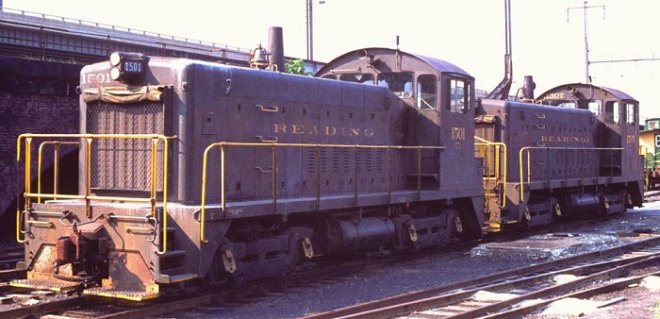
The Reading rostered a total of 21 EMD SW900 locomotives numbered #1501-1521. These units were a familiar sight all over the Reading system from the early 1960s well up into the Conrail era, and had the typical appearance of an EMD end-cab switcher. Since they were all numbered in the 1500 series, and had the same general appearance, it would be easy to assume that they were all identical. However, these locomotives arrived on the Reading in three distinct groups at three separate times. We will look at each group separately, as this information is important to consider when seeking to develop an accurate motive power roster.
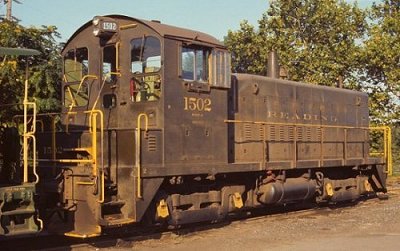
The first group of SW900s was numbered #1501-1510, and entered into service in 1961. This group of locomotives was actually "rebuilt" from Baldwin VO-660 locomotives #61-70, though they were essentially new units, as the trucks were the only parts re-used from the Baldwins. All units were delivered in the first-generation Pullman Green scheme, and were built with full-length handrails along the walkway. SW900s #1501-1606 were classed SWE-4 (SWitcher, EMD, Radio). Locomotives #1507-1510 were classed SWE-14 (SWitcher, EMD, MU equipped, Radio). This group of SW900s saw service all over the Reading system, from Philadelphia to the coal regions and the branches in between. All ten locomotives in the first group of SW900s survived into the Conrail era, though none appear to have been repainted into later Reading paint schemes. The old and "new" locomotives are shown in the following table:
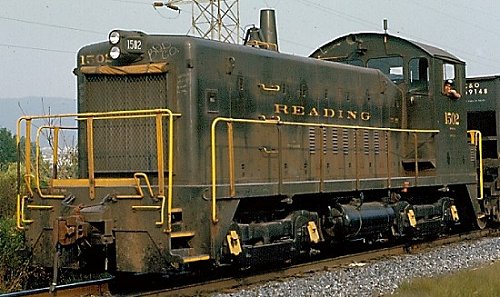
|
VO-660 |
SW900 |
|
61 |
1501 |
|
65 |
1502 |
|
68 |
1503 |
|
64 |
1504 |
|
62 |
1505 |
|
63 |
1506 |
|
66 |
1507 |
|
67 |
1508 |
|
69 |
1509 |
|
70 |
1510 |
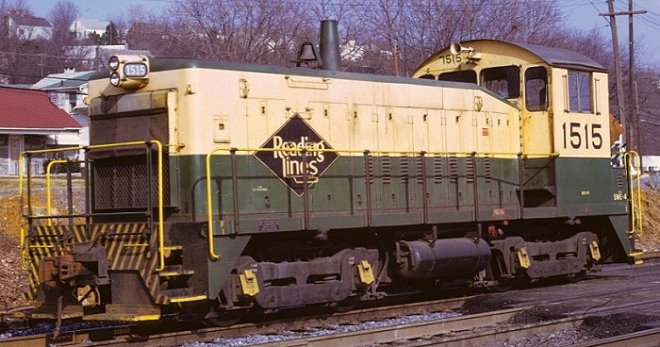
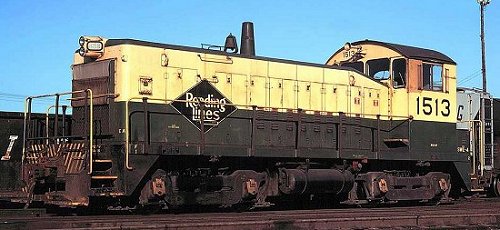 The second group of SW900 locomotives to arrive on the Reading were five units numbered #1511-1515 that were delivered in December, 1963. These units were classed SWE-4, and were delivered in the second-generation yellow-and-green paint scheme. It is important to note that these SW900s were delivered new directly from EMD, and were not rebuilt from older Reading locomotives. These units worked primarily in the Philadelphia, Coatesville and Reading areas, and lasted into the Conrail era. None were known to have been repainted into the 1970s Reading Green scheme.
The second group of SW900 locomotives to arrive on the Reading were five units numbered #1511-1515 that were delivered in December, 1963. These units were classed SWE-4, and were delivered in the second-generation yellow-and-green paint scheme. It is important to note that these SW900s were delivered new directly from EMD, and were not rebuilt from older Reading locomotives. These units worked primarily in the Philadelphia, Coatesville and Reading areas, and lasted into the Conrail era. None were known to have been repainted into the 1970s Reading Green scheme.
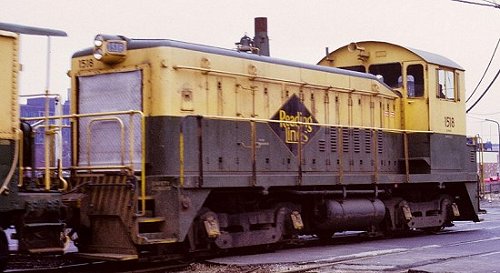 The final group of of 6 SW900s were actually rebuilt from class OE-13 EMD SW/SW900 locomotives #10-13. This rebuilding took place in 1970-1971, and was actually the SECOND rebuilding of these locomotives! Click here for details on this earlier class of Reading switchers. These units were actually considered "SW900m" locomotives, were assigned the Reading Class SWE-4, and numbered #1516 - 1521. The most readily visible differences between the SW900ms and their earlier counterparts are the presence of both a carbody AND a walkway handrail. Also, on these units, the Reading diamond was placed further back on the hood. Finally, #1518 received a smaller road number on the cab side than its sister units, as shown at left.
The final group of of 6 SW900s were actually rebuilt from class OE-13 EMD SW/SW900 locomotives #10-13. This rebuilding took place in 1970-1971, and was actually the SECOND rebuilding of these locomotives! Click here for details on this earlier class of Reading switchers. These units were actually considered "SW900m" locomotives, were assigned the Reading Class SWE-4, and numbered #1516 - 1521. The most readily visible differences between the SW900ms and their earlier counterparts are the presence of both a carbody AND a walkway handrail. Also, on these units, the Reading diamond was placed further back on the hood. Finally, #1518 received a smaller road number on the cab side than its sister units, as shown at left.
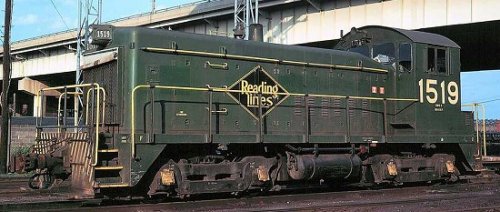 When rebuilt, all units were initially painted in the yellow-and-green paint scheme. However, #1519 was repainted into the final Reading Green paint scheme in 1972, as shown at left. Like the other SW900s on the Reading, these units saw service in Philadelphia, Coatesville, and Reading, and all 6 survived until the Conrail era.
When rebuilt, all units were initially painted in the yellow-and-green paint scheme. However, #1519 was repainted into the final Reading Green paint scheme in 1972, as shown at left. Like the other SW900s on the Reading, these units saw service in Philadelphia, Coatesville, and Reading, and all 6 survived until the Conrail era.
MODELING NOTES: As the EMD SW900 was a very popular locomotive, commercial models are available in the common scales. A few modifications will be necessary to "Reading-ize" your models. All Reading SW900s had handrails along the walkway - these will likely need to be added to commercial models. If you are modeling the last group of SW900m locomotives #1516-1521, note that these units also kept the handrail on both sides of the carbody in addition to the walkway handrails. When adding the rain gutters on the cab, it's best to work from a prototype photo, as not all locomotives had them installed. Finally, when painting and lettering your models, remember that the first group, #1501-1510, wore Pullman green through their entire careers, while #1511-1521 were delivered in yellow-and-green. Another decaling note - the Reading diamond was applied further toward the cab on #1516-1521 than on #1511-1515. Operationally, the SW900s were versatile locomotives that could be used across the system, but most commonly in Coatesville, Reading and Philadelphia. Since 16 of the 21 SW900s were rebuilt at various times, keep in mind the units from which they were rebuilt to avoid implausibility.
Did You Know?
Downloads
 A variety of Reading Company operations related documents, etc. that may be of use in your modeling efforts.
A variety of Reading Company operations related documents, etc. that may be of use in your modeling efforts.
 A variety of Reading Company operations paperwork, such as train orders, clearance forms, etc. that will help you operate your Reading layout in a prototypical manner.
A variety of Reading Company operations paperwork, such as train orders, clearance forms, etc. that will help you operate your Reading layout in a prototypical manner.
 Public Timetables, Employe Timetables, and Rulebooks that provide much useful operational information.
Public Timetables, Employe Timetables, and Rulebooks that provide much useful operational information.
 Signs, billboards, and other FREE goodies for your use. We ask only that you help spread the word about The Reading Modeler!
Signs, billboards, and other FREE goodies for your use. We ask only that you help spread the word about The Reading Modeler!

